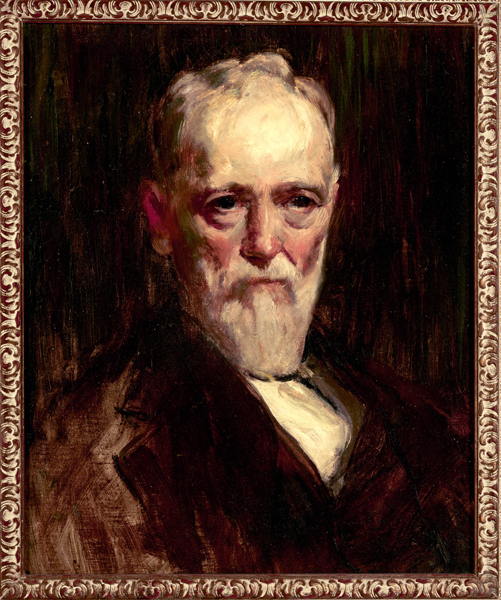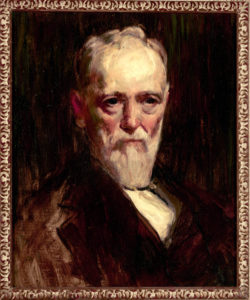William Woodward
William Woodward was a prolific painter, etcher, potter, historic preservationist, architect, teacher, and promoter of art in late nineteenth- and early twentieth-century New Orleans.

Courtesy of The Historic New Orleans Collection
William Woodward. Woodward, Ellsworth (Artist)
Sometimes called “the father of art in New Orleans,” William Woodward was a prolific painter, etcher, potter, historic preservationist, architect, teacher, and promoter of art. Active in late nineteenth- and early twentieth-century New Orleans, Woodward is perhaps best known for his impressionist paintings featuring the architecture of the French Quarter. Like his brother Ellsworth, William Woodward expounded the ideals of the Arts and Crafts movement—an artistic reaction against the effects of industrialization and machine manufacturing on aesthetics. He founded Tulane University’s school of art and helped establish its department of architecture, shaping the New Orleans art world for generations to come.
Early Life and Work
Born in Seekonk, Massachusetts, on May 1, 1859, Woodward became interested in art after visiting the Centennial Exhibition in Philadelphia in 1876. A year later, he enrolled at the Rhode Island School of Design, graduating in 1883. He went on to complete additional study, first at the Massachusetts Normal Art School and then through correspondence with the Academie Julian in Paris.
William arrived in New Orleans in 1884, having accepted an appointment as professor of art and architecture at Tulane University, then in its first year of existence as a private institution. A year later, Ellsworth Woodward joined the Tulane faculty as a professor of drawing and painting. William played an important role in the development of Tulane as an educational institution. In 1886, he helped establish Sophie Newcomb College, a women’s college affiliated with Tulane. In 1894, he helped design both the layout of the campus and the appearance of its buildings when Tulane moved to its present location. Noncoincidentally, Woodward helped establish the Tulane School of Architecture in the same year.
Woodward and the French Quarter
During this time, William continued to teach, paint, etch, and promote the visual arts at Tulane and in evening classes for the public. His classroom significance is impossible to measure; he influenced countless aspiring artists in a career spanning more than a quarter-century. But it is his artistic output, measured in volume and focus alike, that comprises his most enduring legacy. Woodward was captivated by the beauty of nature. “The majesty of the earth gets my blood circulating—that’s good stuff,” he once observed. Yet he is best known for his exploration of French Quarter architecture, usually executed in a muted, softly focused impressionist style.
Woodward’s French Quarter work verged on the exhaustive, a project spurred by his own sense of urgency. He painted, quite literally, as the Quarter crumbled all around him, circumstances that led directly to a second career in historic preservation. He spoke publicly of the need to save the city’s unique architectural heritage, sometimes advocating the preservation of specific structures such as the Cabildo. Other times, Woodward spoke more generally, opposing several early twentieth-century initiatives to “modernize” New Orleans by razing the Quarter and extending the Central Business District across Canal Street. Ultimately, Woodward’s influence received institutional expression with the establishment of the Vieux Carré Commission in 1936.
Later Career
In addition to his easel work and etchings, Woodward was a muralist, drawn to a form whose creative process he once likened to “writing a musical then performing it on stage.” But murals not only required careful planning, they represented a commensurate physical challenge. During the months often required to complete a design, he asserted, his right arm became visibly larger than his left and required constant massaging. But in 1921, mere ache gave way to sheer agony. After doctors removed a tumor from his spine in 1921, Woodward was confined to a wheelchair. He convalesced in Ocean Springs, Mississippi, where he and his wife, Louise Amelia Giesen, had summered since 1891. Then, in 1923, the Woodwards settled in Biloxi, Mississippi, where, despite his handicap, he continued to paint.
Following a brief illness, William Woodward died in New Orleans on November 17, 1939, just eight months after his brother. With their deaths, the New Orleans art world lost two of its most important and influential leaders. William Woodward’s work is included in the collections of the Louisiana State Museum, The Historic New Orleans Collection, The New Orleans Museum of Art, and the High Museum in Atlanta.
